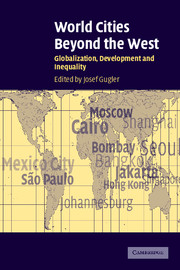Book contents
- Frontmatter
- Contents
- List of figures
- List of maps
- List of tables
- List of contributors
- Acknowledgments
- World cities beyond the West
- Introduction
- Part 1 The impact of the global political economy
- Part 2 The impact of the state
- 6 Moscow's changing fortunes under three regimes
- 7 Hong Kong's pathway to becoming a global city
- 8 Singapore: forming the family for a world city
- 9 Jakarta: globalization, economic crisis, and social change
- Part 3 The impact of popular movements
- Afterword
- Index
- References
8 - Singapore: forming the family for a world city
Published online by Cambridge University Press: 12 October 2009
- Frontmatter
- Contents
- List of figures
- List of maps
- List of tables
- List of contributors
- Acknowledgments
- World cities beyond the West
- Introduction
- Part 1 The impact of the global political economy
- Part 2 The impact of the state
- 6 Moscow's changing fortunes under three regimes
- 7 Hong Kong's pathway to becoming a global city
- 8 Singapore: forming the family for a world city
- 9 Jakarta: globalization, economic crisis, and social change
- Part 3 The impact of popular movements
- Afterword
- Index
- References
Summary
The Republic of Singapore is a premier example of a state whose developmental trajectory started by taking into account its international and regional location. The government explicitly repositioned the city-state to utilize its historical legacy, spatial location, economic heritage, political structure, and the demographic and ethnic constituency. Two decades after independence, Singapore already emerged as a global “city,” a feat that took others a century to accomplish.
This chapter explores the use of the social services to promote Singapore's status as a world city. A hallmark of Singapore's policy making is the ongoing attention to the comparative advantages and disadvantages of a nation of the “South.” The state applies social engineering to direct the economy and society to affect the nation's place in the global economy. To legitimize its programs, the populace is exhorted to see its fate linked to that of their country and its world status. There are ongoing efforts to anticipate change and adjust manpower policies. Integration into the world economy occasions immense social dislocations, which the social services continue to moderate. The policies at first fit a particular set of circumstances, but dynamically change with conditions (Ho 1995).
I focus on the government's molding a new family on behalf of its development program, the best-known example in a market economy of a society restructured by the state. Social policies shape people's goals as well as how they reach their objectives.
- Type
- Chapter
- Information
- World Cities beyond the WestGlobalization, Development and Inequality, pp. 240 - 267Publisher: Cambridge University PressPrint publication year: 2004
References
- 1
- Cited by

